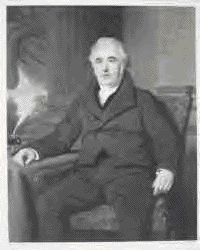Clan of the Cat | home
Site Index | Early Clan History | History | History Cont. | Yet Another Version | Mackintosh Chiefs | Sept Clans of MacKintosh | MacKintosh Battles | MacKintosh of Glenshee | Dalmunzie MacKintoshes | MacKintosh of Ballachraggan | MacKintosh of Finegand | MacKintosh of Cams | MacThomas-Mackintosh's | McCombie-Mackintosh's | Mackintoshs of Atholl | MacKintosh of Kyllachy | McIntosh of Holm | Mackintosh of Farr | Mackintosh of Dunkeld | McIntosh in NA. | Mackintosh Provosts | Col Anne MacKintosh | Chief Wm. McIntosh | Charles Rennie Mackintosh | Charles Macintosh Inventor | Wm Mackintosh of Borlum | John Mohr Mackintosh | Gen. Lachlan Mackintosh | Ewart Alan Mackintosh | Robert Mackintosh | Sir James Mackintosh 1765 | Donald McIntosh | Clan Chattan | Clan Shaw | Tartans | Arms & Clan Crest | Books about Mackintosh | Clan MacKintosh NA | Related Links | Web Awards
Charles Macintosh Inventor

Charles Macintosh was born in 1766. His father originally came from the Highlands, moving to Glasgow to set up a factory in Dennistoun in 1777 to manufacture a violet-red dying powder made from lichens (cudbear).
Macintosh had a strong interest in chemistry. In 1818, while analysing the by-products of a works making coal gas, he discovered dissolved indiarubber. He joined two sheets of fabric together with this solution, allowed them to dry, and discovered that the new material could not be penetrated by water - the first rainproof cloth!
Together with chemist George Hancock, Macintosh solved many of the problems involved in reliably producing waterproofed sheets and coats.
The material was first introduced in 1824 as Mackintosh (with an additional "k"). Macintosh founded his own waterproofing company in Glasgow in 1834 - mainly because to the opposition he faced from tailors, who wanted nothing to do with his new cloth - but moved to Manchester in 1840 to exploit the material further. The factory is now owned by the Dunlop Rubber Company.
Although Macintosh is best known for his eponymously-titled coats, he was a brilliant chemist with achievements in many different fields. He invented a revolutionary bleaching powder (along with Charles Tennant), devised a way of using carbon gases to convert malleable iron to steel by a short-cut method, and worked out a hot-blast process with James Neilson to produce high quality cast iron.
Macintosh was also associated with David Dale in the making of turkey-red dyeing in Scotland, and established the first Scottish alum (a double sulphate of aluminium and potassium) works.